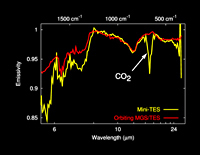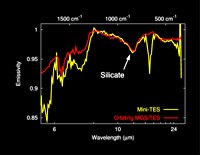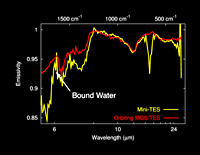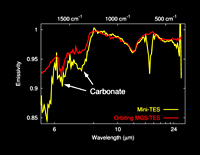Spectra of martian dust taken by the Mars Exploration Rover Spirit's mini-thermal emission spectrometer are compared to that of the orbital Mars Global Surveyor's thermal emission spectrometer. The graph shows that the two instruments are in excellent agreement.
Rover Senses Carbon Dioxide  Click on image for larger view
Click on image for larger view
This graph, consisting of data acquired on Mars from the Mars Exploration Rover Spirit's mini-thermal emission spectrometer, shows the light, or spectral, signature of carbon dioxide. Carbon dioxide makes up the bulk of the thin martian atmosphere.
Rover Senses Silicates  Click on image for larger view
Click on image for larger view
This graph, consisting of data acquired on Mars by the Mars Exploration Rover Spirit's mini-thermal emission spectrometer, shows the light, or spectral, signature of silicates - a group of minerals that form the majority of Earth's crust. Minerals called feldspars and zeolites are likely candidates responsible for this feature.
Rover Senses Bound Water  Click on image for larger view
Click on image for larger view
This graph, consisting of data acquired on Mars from the Mars Exploration Rover Spirit's mini-thermal emission spectrometer, shows the light, or spectral, signature of an as-of-yet unidentified mineral that contains bound water in its crystal structure. Minerals such as gypsum and zeolites are possible candidates.
Rover Senses Carbonates  Click on image for larger view
Click on image for larger view
This graph, consisting of data from the Mars Exploration Rover Spirit's mini-thermal emission spectrometer, shows the light, or spectral, signatures of carbonates - minerals common to Earth that form only in water. The detection of trace amounts of carbonates on Mars may be due to an interaction between the water vapor in the atmosphere and minerals on the surface.

